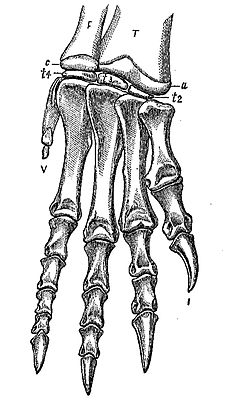Ammosaurus
| Ammosaurus | ||||||||||
|---|---|---|---|---|---|---|---|---|---|---|

Ammosaurus foot skeleton (drawing by Marsh 1889). |
||||||||||
| Temporal occurrence | ||||||||||
| Lower Jurassic ( Pliensbachian or Toarcian ) | ||||||||||
| 190.8 to 174.1 million years | ||||||||||
| Locations | ||||||||||
|
||||||||||
| Systematics | ||||||||||
|
||||||||||
| Scientific name | ||||||||||
| Ammosaurus | ||||||||||
| Marsh , 1891 | ||||||||||
| Art | ||||||||||
|
Ammosaurus is a basal (original) genus of the sauropodomorphic dinosaur . She lived in the Lower Jurassic North America and is known from four incomplete, skullless skeletons thatwere recoveredin Connecticut from the layers of the Portland Formation ( Newark supergroup ). Other material possibly belonging to this genus comes from Nova Scotia and Arizona , although the Arizona material could also belong to Massospondylus . Various recent studies come to the conclusion that Ammosaurus is identical to Anchisaurus ; the name Ammosaurus would be invalid in this case.
The only valid species is Ammosaurus major . The name Ammosaurus means something like "sand lizard" ( Greek ammos - "sand", sauros - "lizard").
features
Ammosaurus was a small representative of the Sauropodomorpha; the holotype skeleton suggests an animal that was between 1.8 and 2.4 meters long. Galton and Upchurch (2004) give three characteristics which are intended to distinguish Ammosaurus from Anchisaurus . However, Yates (2010) comes to the conclusion that two features on the pelvic bones could have been artifacts that were poorly preserved and therefore not usable for the system, while the third feature, the relatively small hallux claw of Anchisaurus , is too insignificant to separate the two genera is. Consequently, Yates describes Ammosaurus as a synonym of Anchisaurus .
Systematics
Together with Anchisaurus , Ammosaurus forms the family Anchisauridae . These forms are among the classic prosauropods , a group that is now considered invalid (because it is paraphyletic ) and is hardly used any more.
Research history
The first skeleton found ( holotype , copy number YPM 208) was excavated in 1884 by the famous paleontologist Othniel Charles Marsh in the Connecticut River valley near Manchester . Although this skeleton was apparently completely preserved, Marsh only hid the posterior section of the skeleton, consisting of three presacral vertebrae, the sacrum (sacrum), the pelvis and both hind legs. Marsh initially described this find as a new species of anchisaurus (Marsh 1889); two years later he created the new genus Ammosaurus .
Marsh attributed Ammosaurus to the Coelurosauria , a group within the theropods. Friedrich von Huene (1914) established a new family, the Ammosauridae, which he considered to be the most primitive group of coelurosaurs. Only a new investigation of the genus by Galton (1971) was able to show that Ammosaurus was not a theropod, but rather a prosauropod. He classified this genus first within the Anchisauridae; in a later publication (Galton, 1990), however, he assigned them to the Plateosauridae .
Marsh described a second species, Ammosaurus solus , based on pelvic and foot bones found in the same quarry from which the holotype specimen came. Today, however, this species is considered identical to Ammosaurus major .
Individual evidence
- ^ Gregory S. Paul : The Princeton Field Guide To Dinosaurs. Princeton University Press, Princeton NJ et al. 2010, ISBN 978-0-691-13720-9 , p. 164.
- ^ A b Peter Galton , Paul Upchurch : Prosauropoda. In: David B. Weishampel , Peter Dodson , Halszka Osmólska (eds.): The Dinosauria . 2nd edition. University of California Press, Berkeley CA et al. 2004, ISBN 0-520-24209-2 , pp. 232-258.
- ↑ Paul Sereno: Anchisauridae. (No longer available online.) In: Taxon Search. Archived from the original on March 23, 2012 ; Retrieved October 12, 2011 . Info: The archive link was inserted automatically and has not yet been checked. Please check the original and archive link according to the instructions and then remove this notice.
- ^ A b Adam M. Yates: A revision of the problematic sauropodomorph dinosaurs from Manchester, Connecticut and the status of Anchisaurus Marsh. In: Palaeontology. Vol. 53, No. 4, 2010, ISSN 0031-0239 , pp. 739-752, doi : 10.1111 / j.1475-4983.2010.00952.x .
- ↑ a b c d Donald F. Glut : Dinosaurs. The Encyclopedia. McFarland & Co, Jefferson NC et al. 1997, ISBN 0-89950-917-7 .
- ^ Othniel C. Marsh : Names of extinct reptiles. In: American Journal of Science. Vol. 129 = Series 3, Vol. 29, No. 170, 1885, p. 169, digitized .
- ^ Adam M. Yates, Matthew F. Bonnan, Johann Neveling, Anusuya Chinsamy, Marc G. Blackbeard: A new transitional sauropodomorph dinosaur from the Early Jurassic of South Africa and the evolution of sauropod feeding and quadrupedalism. In: Proceedings of the Royal Society. Series B: Biological Sciences. Vol. 277, No. 1682, 2010, ISSN 0950-1193 , pp. 787-794, doi : 10.1098 / rspb.2009.1440 .
- ^ Othniel C. Marsh: Notice of new American dinosaurs. In: American Journal of Science. Vol. 137 = Series 3, Vol. 37, No. 220, Article 35, 1889, pp. 331-336, digitized .
- ^ Othniel C. Marsh: Notice of new vertebrate fossils. In: American Journal of Science. Vol. 142 = Series 3, Vol. 42, No. 249, Article 26, 1891, pp. 265-269, digitized .
- ↑ Peter M. Galton : The prosauropod dinosaur Ammosaurus, the crocodile Protosuchus, and their bearing on the age of the Navajo sandstone of northeastern Arizona. In: Journal of Paleontology. Vol. 45, No. 5, 1971, ISSN 0022-3360 , pp. 781-795.